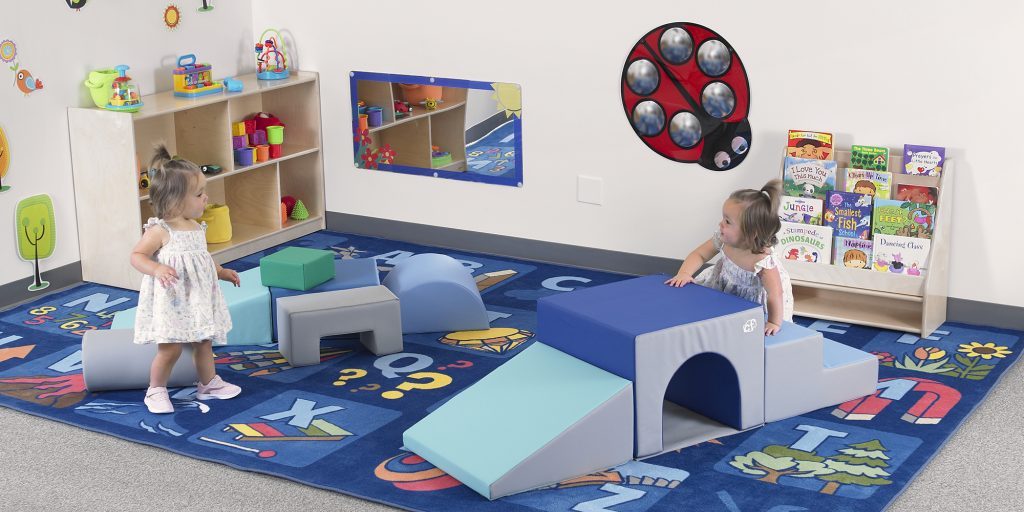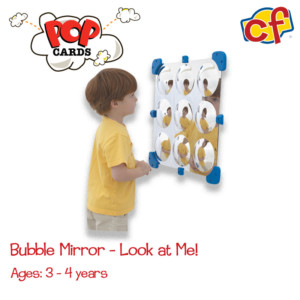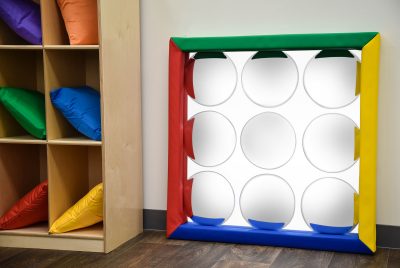
Lesson Plan Bubble Mirror
POWER OF PLAY (POP)
 “Play is the essential ingredient, the vehicle by which children communicate, socialize, and learn about the world around them, understand themselves and others, deal with their problems, and practice some of the skills they will use in the future” (Hartley, 1971)
“Play is the essential ingredient, the vehicle by which children communicate, socialize, and learn about the world around them, understand themselves and others, deal with their problems, and practice some of the skills they will use in the future” (Hartley, 1971)
Environmental Set-up:
Children love creative dramatic play!
The Bubble Mirror is an innovative and unique mirror that provides multiple perspectives, in contrast to the standard mirror.
- Install/secure Bubble mirror in horizontal position at children’s eye level.
- Provide suitcase/box of culturally appropriate clothes/artifacts to be used by the children as props in dramatic play
Objectives:
- Provides multiple images and perspectives of child, peers and environment;
- Imagining & experimenting with “roles” that reflect the culture & society child lives in;
- Conversational language development
Activity Overview:
Children select from a choice of props in dramatic play box and “dress up.” Children use bubble mirror (each with their own bubble) to look at themselves and each other in their “costume.” Socio-dramatic play enables children to act out interpretations of a role and to talk about “who they are” i.n this dramatic role.
- Provide time for children to experience the process of “dress-up” and the reflection of themselves. transformed by costume.
- If not spontaneous, use guiding questions to facilitate the “scenario” they are imagining in their minds.
Guiding Questions:
“Look at you! You’re a (fireman, daddy, doctor, etc.). What tools do you need to be a ?” If a child has on, for example, an apron and chef’s hat, you might ask what he is planning to cook next or what he just finished cooking or preparing.
Implications for Brain Development:
The brain, organizing and integrating different thoughts, ideas, and pieces of information learned earlier in life, allows the child to imagine possibilities through dramatic play. In contrast to a traditional flat mirror, the Bubble Mirror provides multiple and varied images of shape and size, linking internal perceptions with visual observations. The child, through imitative and dramatic play and 3-dimensional mirror imagery (evident from Bubble Mirror) begins to stimulate the brain development that produces 3- dimensional perceptions. This helps to refine the child’s internal representation of the external world.
Developmental Learning Outcomes:
Sensory-Motor/Physical Development:
- Improved motor coordination • Enhanced internal sensory-motor organization
- Improved ability to interpret constancy in image size and shape
Cognition Development:
- Enhanced imagination & creativity; • Identification, classification, and matching of clothing/tools;
- Emergence of primitive reasoning and problem solving.
Language Development:
- Understanding of basic rules of conversation;
- Increased expressive vocabulary through discussion of roles and dramatic characters.
Social/Emotional Development:
- Expression of feelings & emotions; • Parallel & Associative play/borrowing & sharing of materials;
- Safe “space” to try out ideas and thoughts.
Activity Variation:
- Give child a camera to take a picture of self in the mirror;
- Provide clothes/props around a theme;
Resources:
Barbour, A. & Desjean-Perotta, B. (2002) Prop Box Play: 50 Themes to Inspire Dramatic Play.
Lewisville, NC: Gryphon House Publishing.The Importance of Dramatic Play. Retrieved November 2009 from www.pbs.org/teachers/earlychildhood/articles/dramaticplay.html
Rationale:
The Bubble Mirror, excellent for this age, provides an individual space for each child to watch self and each other while assuming a real or imaginary role, as well as to talk with each other. Socio-dramatic play involves make-believe and imaginative elements that provide the foundation for developing cognitive skills of abstract thinking and problem solving.
Primary Development Areas Addressed: • Social/Emotional • Language
Number of children: 1, 2-3, 3-5
